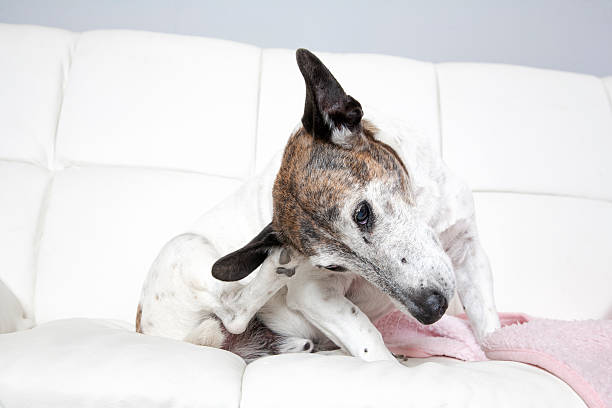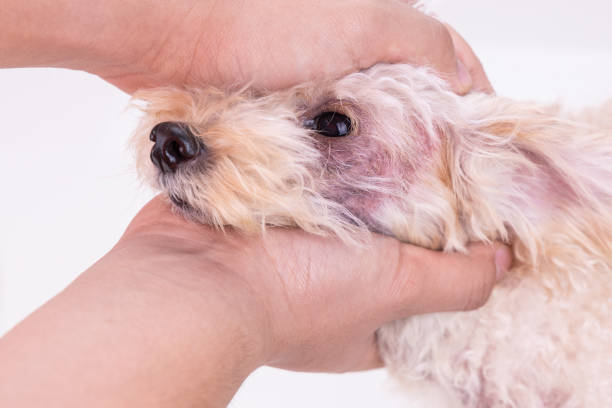Flea infestations have long been a frustrating problem that dog owners and their pets deal with. There are a plethora of flea treatment products available in the market. However, it seems that some pet owners may not be applying these treatments as often as they should. Dog flea medication may not completely resolve the issue, but it can assist in curbing the reproduction of adult fleas. It’s essential to give your dog the appropriate medication at the necessary times.
There are many different types of prescription flea medication for dogs. Some of these products may be more effective in killing fleas than others. Flea control products are effective and safe for your dog. However, it is important to regularly give your pet the proper dosage of flea medication. You can find prescription flea medications for dogs in many different forms. Some of these forms include:
- Flea shampoos
- Natural flea sprays
- Flea collars
- Flea dips
- Flea powders and liquids
- Flea collars work by trapping fleas and ticks within the collar
- Flea combs
How to Tell if Your Dog Has Fleas


Adult fleas are easier to spot, especially if your dog has a thin coat. But in other cases, fleas are harder to spot when these parasites are in the early stage of their flea life cycle. Fleas are tiny parasites that can be very difficult to spot and cause a lot of dog scratching. There are several ways to tell if your dog has fleas, and some of them include looking for the following:
- Flea allergy dermatitis
- Flea dirt and debris
- Flea faeces and flea poop
- Flea eggs on your dog’s fur
- Flea eggs on your dog’s skin
- Dirty or dead fleas attached to the hair
- Fleas that are found near the base of your dog’s tail
- Small black flea specks on your dog’s skin
Flea’s Life Cycle and Reproduction


Fleas generally only live for about two months, but they can survive up to a year. The female adult fleas lay their eggs in larger quantities than males and can lay about 8 – 12 eggs daily. The flea larvae hatch in 3 days, then go through 4 moult stages before reaching maturity.
The eggs are laid in the haircoat, around the base of the neck, and on the back and underbelly. Flea eggs are oval-shaped, about 1/16″ long, and tan or light yellow. The eggs hatch in 3 to 4 days and the newly hatched larvae are whitish, legless, and can be seen scurrying about. The larva is called a flea pupa.
The flea pupae is a white, round, hard nodule about 1/16″ to 1/8″ in diameter. When the flea pupae hatch from the egg, it eats voraciously for about 3 minutes and enters the eggshell. The pupa is called a cocoon. The cocoon is made from the webbing of the flea body, which breaks down, and the larva emerges from it as an adult flea (it has outgrown its old skin).
Flea adults are wingless, oval-shaped, and about ¼” long. Fleas are about ½” to 3/4″ long, depending on the species. Often, flea bodies are seen with three pairs of legs and one pair of antennae, but some species have four or five pairs of legs.
The Symptoms Of Flea Infestation In Dogs


Fleas are a common problem for dogs and can cause various symptoms. Some common symptoms of the flea:
- Itching and scratching
- Red bumps or lesions on the skin
- Excessive licking of the paws
- Bald patches, especially around the neck and base of the tail
- Tapeworms
- Flea dirt
If your dog is showing any of these symptoms, it is important to treat them for fleas.
Flea Treatments


Fleas are a common problem for both dogs and cats. They can cause skin irritation and hair loss. In severe cases, fleas can transmit tapeworms to pets. The best way to treat a dog for fleas is to use a combination of products, including topical medication, a flea collar, and a monthly heartworm preventive.
Flea collars are a good way to control fleas, but they are not ideal for dogs with long coats. To use the collar correctly, you must place the collar around your dog’s neck and fasten it tight. You must also check your dog’s ears and the rest of their body for fleas and flea dirt. If you find any fleas on your dog, you should use a flea comb to remove them.
- Get rid of fleas on your dog with a flea comb.
- Kill fleas on your dog with a flea collar.
- Use a flea shampoo to get rid of fleas on your dog
- Use a flea spray to get rid of fleas on your dog
- Use a flea dip to get rid of fleas on
How To Prevent Fleas And Ticks
Fleas and ticks are two of the most common issues dog owners face. These pests can cause various dog problems, including skin irritation, infection, and even paralysis. Fortunately, there are several things that dog owners can do to help prevent their dogs from getting fleas and ticks.
Get a Flea and Tick Collar
A flea collar is a great way to get rid of fleas and ticks on your dog. These collars are designed to emit an insecticide that kills adult fleas that have landed on your dog.
Use Flea and Tick Spray
Fleas and ticks are common parasites that can infest dogs, cats, and other animals. Many effective treatments are available to kill adult fleas and ticks, including flea and tick sprays. Flea and tick sprays are applied to an animal’s fur to kill fleas and ticks. These flee products are available as over-the-counter or prescription medications.
You may also try using: Billy No Mates Herbal Flea, Tick & Mite Repellent
Keep Your Yard Clean And Clean Up After Your Dog


Keep your yard clean and keep it clean after your dog. The best way to discourage ticks is to remove any brush, brush up the grass, and ensure there are no leaves or sticks in the yard. If you live in an area with a high risk of tick infestation, you should consider not letting your dog go into public areas.
Ticks can infect a dog’s fur, skin, and mouth. Ticks are known to attach to dogs while they are sleeping or playing. The ticks burrow into a pet’s skin, where they attach themselves and begin feeding on blood.
Kill adult fleas you see on your dog or anywhere you see them. Keep your yard free of flea-infested debris. Flea collars should be worn for at least 30 days to kill fleas. This is the minimum amount of time required for a flea collar to be effective.
Use Flea and Tick Shampoo
Regularly shampooing your dog is a great way to eliminate fleas and ticks. The shampoo will kill the pests that have gotten on your dog, making it easier for you to identify them and find the best treatment for them.
Vacuum Regularly
Vacuuming regularly is an important part of keeping your pet free of fleas, and it’s also a good way to get rid of any other dirt or debris that may be lurking in your home.
Check Your Pets for Ticks
If you are a pet owner, you must be aware of the dangers that ticks and fleas pose to your pet. Both ticks and fleas can carry a variety of diseases, which can be deadly to your pet. It is important to check your pet for ticks and fleas regularly and treat them for these pests if necessary.
Natural Flea Control
Fleas can cause skin irritation and can also transmit diseases. Many commercial flea products are available to treat dog fleas, but many natural methods can also be used. Natural methods may be slower than commercial products, but they are usually less expensive and safer for pets and people.
Natural flea control can include using cat and dogs shampoo to remove fleas from your pet’s coat. Shampoos are usually made from a mixture of ingredients, including water, soap, oils, and fragrances. These ingredients kill the fleas on contact.
Other natural flea control methods include natural flea spray using essential oils, diatomaceous earth, and apple cider vinegar. These methods can effectively control fleas, but it is important to use them regularly and in combination with a commercial product for the best results.


